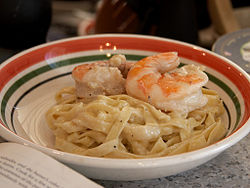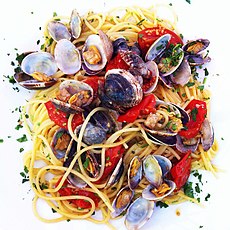Fettuccine Alfredo
 Fettuccine Alfredo topped with shrimp, a typically American variation on the original recipe | |
| Course | Primo |
|---|---|
| Place of origin | Italy |
| Region or state | Lazio |
| Associated cuisine | United States |
| Created by | Alfredo di Lelio I (1882-1959) |
| Serving temperature | Hot |
| Main ingredients | fettuccine, Parmigiano-Reggiano cheese, butter |
| Variations | (in the US) broccoli, cream, parsley, garlic, chicken, shrimp |
 |
| Italian cuisine |
|---|
|
|
Fettuccine Alfredo is a pasta dish made from fettuccine tossed with parmesan cheese and butter. As the cheese melts, it emulsifies the liquids to form a smooth and rich coating on the pasta. The term is a synonym for pasta with butter and Parmesan cheese (Italian: pasta al burro e parmigiano), one of the oldest and simplest ways to prepare pasta. The dish was named by Alfredo Di Lelio I, a restauranteur who opened and operated restaurants in Rome, Italy, throughout the early to mid 20th century.[1] While the term "Fettuccine Alfredo" is especially popular in the United States, in Italy the dish is largely unknown under that name. The American version of Fettuccine Alfredo is usually richer and very different from the original recipe created by Alfredo Di Lelio I.
History
Fettuccine with butter and Parmesan cheese was first mentioned in the 15th-century cookbook, Libro de arte coquinaria, written by Martino da Como, a northern Italian cook active in Rome.[2] The name of the dish, "Maccheroni romaneschi" (English: Maccheroni the Roman way), betrays its Roman origin. The dish became soon a staple food in Italy and abroad. [3]
The dish was invented by Alfredo di Lelio I at his restaurant, Alfredo, in 1914 as a variation of "Fettuccine al burro". When butter was added both before and after fettuccine was put in the serving bowl, the dish was known as "doppio burro" (double butter). Di Lelio's "original contribution" was to double the amount of butter in the bowl before the fettuccine would be poured in, thus a "triplo burro" (or "triple butter") effect instead of double which he started doing for his pregnant wife who was having difficulty keeping food down.[4] Alfredo added the new dish to his restaurant's menu when his wife began eating again.
A long-time customer recounted that di Lelio's restaurant became famous when Mary Pickford and Douglas Fairbanks stopped in and fell in love with the dish while on their honeymoon in 1920. To express their gratitude, they gave him a golden fork and spoon along with a photo of them eating in his restaurant. He proudly displayed the photo on the wall. Pickford and Fairbanks served his dish to their friends and associates when they returned to Hollywood. Word about the new dish quickly spread.[5]
Alfredo di Lelio sold his restaurant on 5 May 1943. The new owner kept the restaurant's name, menu, traditional recipes, photos on the wall, and everything else; as of 2011, the restaurant is still in business under the name, "Alfredo alla Scrofa".[6] In 1950, Alfredo Di Lelio I, together with his son Armando, opened "Il Vero Alfredo" at Piazza Augusto Imperatore which is still managed by the grandchildren Alfredo Di Lelio III and Ines Di Lelio, continuing the tradition of the original fettuccine created by their grandfather.
That expansion continued in 1977 when Alfredo II and Guido Bellanca opened a new "Alfredo's" by Rockefeller Center in New York City The walls of that restaurant, including the rest rooms, are plastered with caricature drawings by Al Hirschfeld. Another Alfredo's opened in the Epcot at Walt Disney World in Lake Buena Vista, Florida. As of September 2007, the Epcot branch is closed.
Fettuccine Alfredo has now become ubiquitous in Italian-style restaurants in the United States. In Italy, the dish which is popular for its simplicity is called "Fettuccine al burro" instead of the mostly unused "Fettuccine Alfredo".[7] [8]
Variations

Basic Fettuccine Alfredo has many modifications to the recipe often used to lower the cost. Cream may be added to the butter. Less expensive cheeses such as American-made Parmesan cheese, an imitation Parmigiano-Reggiano, are often used. Additionally, the cheese is sometimes mixed with flour as a thickener. Thickening can also be achieved by mixing the sauce with a small amount of roux (flour and liquid butter or olive oil) as the liquid reaches boiling.
Occasionally, other cheeses such as asiago and romano may be added to alter the flavor. Other types of pasta are sometimes used. To make it a single-dish meal, chicken/shrimp and vegetables such as peas, are often served on top. Another variation uses egg in combination with cream, butter and cheese.
Alfredo sauce
Alfredo sauce is often sold as a convenience food in many grocery stores in the United States. Unlike the original preparation, which is thickened only by cheese, these versions may be thickened with starch.
References
- ^ Downie, David (2011). Cooking the Roman Way. HarperCollins. p. 106. ISBN 9780062031099.
- ^ de Rossi, Martino. Libro de Arte Coquinaria. pp. sub vocem.
- ^ "The food timeline". Retrieved 23 April 2014.
- ^ Luigi Carnacina and Vincenzo Buonassisi, Roma in Cucina, Martello, Milan, 1968, sub vocem
- ^ Paul Hofmann, (November 1, 1981), "Fettuccine- A Dish Fit for a Duchess", New York Times, accessed 2008
- ^ Web site of "Alfredo alla Scrofa" in Rome
- ^ "Fettuccine Alfredo". Giallo Zafferano. Retrieved 2 April 2014.
- ^ Bastianich, Lidia; John, Mariani. How Italian Food Conquered the World (1st ed.).
